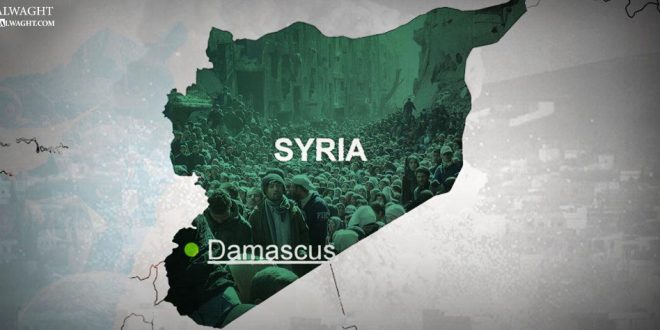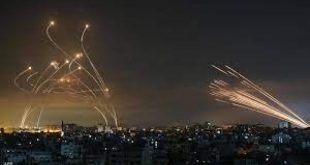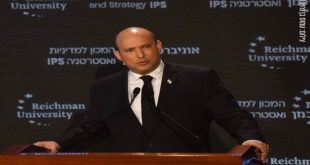Alwaght– Early this week, the UN Syria envoy Staffan de Mistura said that Syria is heading to a catastrophic partition, warning that the war-hit nation could see the return of the ISIS terrorist group if no inclusive peace settlement is reached.
The envoy, addressing the audience at the Geneva Graduate Institute, said: “The truth is that a soft, long-term partition of Syria, which (is) the one that we are witnessing at the moment, in different areas of control, will be a catastrophe, not only for Syria but for the whole region.”
Not only UN worried
But the UN is not the only party that is concerned about the risks of the partition of Syria. The central government of Syria has growing worries, too. Other parties, mainly Iran and Russia, in the past warned some foreign sides against taking measures that could result in breaking Syria into smaller parts. The Russian Foreign Minister Sergey Lavrov has recently pointed to the issue during a speech at a summit in Russia’s resort city of Sochi. He said that the US seems to have taken a course toward dividing Syria that Russia is aware of and will ask Washington about it.
The Islamic Republic of Iran has also over and over accused the Western powers, especially the US, of seeking to divide Syria by offering various kinds of support to the armed groups fighting the legitimate government in Damascus. In late February, the Iranian Foreign Minister Mohammad Javad Zarif, addressing a conference titled “Russia in the Middle East: Playing on All Fields”, held that some of the Kurdish groups are exploited by the foreign parties. He pointed to the abuse of the Kurdish Democratic Union Party of Syria, saying that Washington realizes Syria division plans by backing the Kurdish group.
All these remarks signal that the concerns about Syria partition are not limited to the UN. Rather, Russia and Iran are severely uneasy with outlooks of the partition of the crisis-hit country. The remarks, moreover, make it clear that Syria division as a dangerous scenario is still a point of debate.
Transferring ISIS to safety for later muscle flexing
Talking about the split of Syria automatically echoes the story of ISIS barbarity over the past years in Syria and seizure of large swaths of territory in the country by this terrorist group. After the fatal blows ISIS received last year from the Syrian army and its allies on the ground, the terrorist group roughly lost its power of influencing the Syrian developments, at least militarily. Still, some interactions of the West with the fundamentalist terrorists herald the Western sides’ plans to revive ISIS on the Syria battle fronts to play a role in the future developments.
Over last year, a series of news came out to relate how the American troops established links with ISIS in Syria and Iraq. The latest news on the case came out just this week when the media reports suggested that US transferred ISIS members in Syria, fueling new concerns about the possibility of the terrorist group’s rise afresh in some parts of Syria on the strength of the Western help.
Last week, the Syrian Arab News Agency (SANA), quoting its local sources, noted that three US helicopters have recently landed in an area between Al-Jaysi and Klu villages, two kilometers away from Tell Hamis town in northeastern Hasakah province. The reports added that the American troops accompanied four people who appeared to be ISIS commanders from their hideout into the helicopter.
This news means that so far at least a number of the radical anti-Damascus militant commanders have been transferred to a secret place by the US helicopters. There have been complaints about similar plots by US forces in Afghanistan. So far, the Afghan members of parliament, mainly those of Nangarhar province, complained that the US was providing secure places for ISIS activities in their country. They protested the US transferring the extremist figures with relations to ISIS. In Iraq, likewise, the foreign forces, and particularly the Americans, have been blasted for helping the terrorists flee to safety. Less than a month ago, the commander of the Iraqi Special Operations Forces, an elite counter-terror unit, drew links between the perpetuation of ISIS terrorists in al-Anbar province and some support offered to them by the foreign actors.
The US moves have raised some questions: Why are US helicopters transferring some ISIS members while the terrorist group has lost the war to the Syrian government in various cities? Is Washington paving the way for ISIS rebirth in Syria while similar efforts are underway in Afghanistan? With regard to the record of occupation and destruction in both Syria and Iraq, will recollection of terrorist militants mean that the US is willing to see parts of Syria and even Iraq recaptured?
Certainly, the reemergence of the terrorist group in parts of Syria with support from a range of anti-Damascus parties, from the like-minded radical groups to the Western and Arab governments, is aimed at posing a fresh challenge to the Syrian territorial integrity. The issue gives every reason to pro-unity parties to bemoan divisive moves.
Replacing pro-unity with pro-division actors
Not all of the Syrian opposition are in favor of partition. For example, the Kurdish Syrians in the north do not seek division from the country. They made that clear recently. Taking to Russia’s Sputnik news agency early this year, Shahoz Hasan, the co-chair of Democratic Union Party (PYD), said that the party was ready for dialogue with the central government. He assured that they are not planning to separate from Syria and build an independent Kurdish state, adding that all rumors about the Kurdish secessionism are untrue.
Despite this group’s announcement about the intention to remain within a united Syria, the PYD came under harshest attacks by the Turkish armed forces who since January 20 started a military intervention, codenamed Operation Olive Branch, in northern Syria to push back the pro-unity Kurds from their positions. The Kurdish operation, in fact, has two aims: Impairment of the pro-unity Kurdish groups and strengthening the position of the Ankara-backed radical factions, including the Free Syrian Army (FSA), and some other separatist armed groups. Ankara’s military intervention should not be construed other than aiming to replace the pro-cohesion Kurdish groups with the separatist Sunnis, something should not be disregarded.
The US comfortable silence, on the other side, over the Turkish invasion of the north despite the past claims of offering support to Kurds in the event of coming under attacks made it clear that the West is not unhappy with seeing the Kurds replaced with the extremist and terrorist factions. Perhaps the US can be held accountable as it in the past provocatively supported the Kurdish territorial seizures on the borders with Turkey and thus gave Turkey the much-needed excuse to invade the northern regions.
Still, what fuels the perturbation about the West’s separatist objectives in Syria is a wave of violent developments and a domino effect of instability that may not stay limited to the borders of a divided Syria. Fears of such a long-term instability, which uses the ethno-sectarian gaps as its currency, can also involve the West’s closest regional allies, including the Saudi Arabia.
 WILAYAH NEWS VOICE OF THE GLOBAL AWAKENING
WILAYAH NEWS VOICE OF THE GLOBAL AWAKENING






